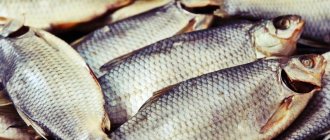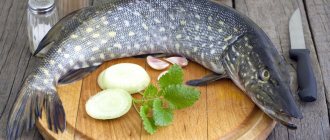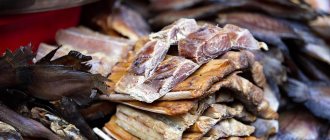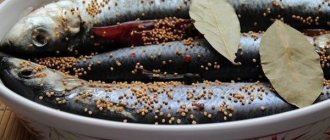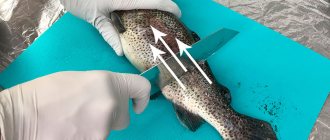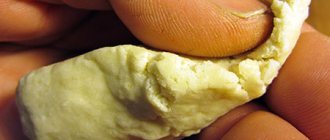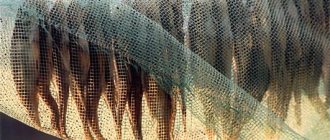Sequence of actions when withering rudd
The technology of drying fish allows you to preserve it for a long time and at the same time makes it possible to subsequently consume the finished product without heat treatment. Therefore, it is extremely important at the stage of preparing and drying rudd to remember exactly the sequence of actions, because this will certainly help get rid of the parasites living in the fish and preserve its meat for a long time. When preparing dried rudd, you need to do the following manipulations:
- clean and gut the fish - especially novice cooks should do these steps carefully, since poorly cleaned rudd with innards not completely removed can deteriorate during the drying stage or acquire an unpleasant aftertaste;
- salt it: when salting, a large number of salt molecules penetrate into the tissues of the fish, which play the role of a preservative and kill pathogenic bacteria and parasites;
- rinse and soak it to remove excess salt, which will adversely affect the final taste of the rudd;
- hang to dry for a long time in a draft or under a stream of air to quickly dry and wilt the rudd.
We will tell you more about how to dry rudd in the cooking recipe.
Roach fishing
In April, fishermen begin to come to the banks of the Volga, and the fishing season begins. Hungry fish, after breeding, readily rush to bait. This period has restrictions on the number of fish caught, so it’s worth finding out in advance to avoid problems with the law.
Story
There were times when preference was given to expensive, red varieties of fish. Then it was noticed that the migration of roach occurs earlier than herring, they began to catch it, but on a small scale. The nutritional value and taste of roach were not immediately appreciated: earlier, when fishing, if it got caught in a net, fishermen often simply threw it away. In the difficult nineties, small and large businessmen decided to sell this fish and were right.
To learn more:
How to wash and preserve bloodworms for fishing
Fishing places
It is difficult to find a specific place on the river bank where a lot of fish are caught, since the roach is constantly on the move. Fishermen choose the area they like and wait for the flock, casting a donk or fishing rod. When the school approaches, the fisherman's hand gets tired of getting the fish, but soon there is a lull, the school swims away, and he again has to wait for the next school. The bait is cast further from the shore, since large fish live in the depths.
Fishing methods
They catch roach using bottom, float rods or a feeder. On the gear used, different attachments are used in the form of: hooks, hooks, weights, feeders. You can attach up to four hooks to a float rod. Since roach fishing takes place in the river flow, a weight or feeder for the feeder must be selected weighing at least 40 grams so that the river current does not carry it away. When the roach bites well, it is troublesome to get the heavy gear you use every time; a light rod is required. Fishing with a feeder with a thick line has become popular. A thick line (0.25 in diameter) does not frighten a hungry fish at all; on the contrary, it greedily pounces on the bait.
Lure
Various porridges with the addition of mixed feed serve as bait for roach. For better fishing, crushed earthworms or maggots should be added to the groundbait or groundbait. You can make bait yourself by finding recipes on the Internet, or purchase ready-made bait at a fishing store.
Dried rudd recipe
For cooking you only need salt and fish:
- rudd - 10-15 pieces,
- salt - 1-1.5 kilograms.
- Number of servings: 10;
- Preparation time: 7-10 days.
We clean the rudd from scales, remove the entrails and films. We rinse and then prepare for salting. Take a deep container, preferably enameled or made of food-grade plastic, and add 1 centimeter of salt to the bottom.
Rub each fish with salt from the inside of the abdomen, stuff the gill covers with salt, and rub into the skin. Place the rudd heads to tail on the salt layer. Add another centimeter of salt on top and then cover with a lid. Let's put a slight pressure on the lid - you can use a jar or a half-liter plastic bottle of water.
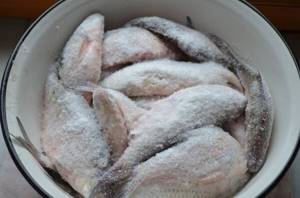
After salting, the rudd should be soaked in cold, clean water. For small fish, soaking takes 8 hours; for fatter rudds, soak for at least 12. You need to change the water often, every couple of hours. After soaking, string the fish on twine or hang it on wire hooks on slats. To dry, place slats or rope on the balcony, under the breeze, and leave for 7-8 days.
Taranka recipe
How to pickle a ram
1. Clean the fish from the entrails. Leave the scales.
It is not necessary to clean carcasses weighing up to 1 kg, since the husks will dry out, but it is still better to gut even small fish, since in the summer they feed on greens and microorganisms, which give off an unpleasant odor, and the finished ram has a bitter taste.
If you still decide to leave the insides, then 10-30 ml of a saturated salt solution (1 part water to 2-3 parts salt) should be poured into the throat of each still living fish; when the fish swallows the brine, the internal organs are well salted.
2. Rinse each fish thoroughly in running water to remove any remaining entrails. Pay special attention to the areas near the head and tail.
3. Cover the bottom of the pickling container with an even 1 cm layer of salt.
4. Salt the gills of each fish, rub the inside with salt, then make one puncture on each side with a fork and rub the top of the carcass well. The gills must be literally compacted with salt or removed altogether so that the ram is guaranteed not to deteriorate.
5. Place the salted fish in layers, one piece at a time. Place the carcasses side by side with the back to the belly and the head to the tail. Cover each layer with a layer of salt approximately 1 cm thick.
For better salting, it is better to place large fish on the bottom and small fish on top. One layer should contain fish of approximately the same size.
6. Place a cardboard or wooden board with holes on top of the fish. To cover round containers, you can use old lids of a smaller diameter. Holes are necessary for air access. Place a weight weighing 10-20 kg on top of the lid. For uniform salting, it is advisable to first add a weight of 5-10 kg, and after 6-8 hours add another 5-10 kg.
7. Transfer the container with the salted batter to a cool, dark place: refrigerator, cellar or basement. It is important that the fish are not exposed to direct sunlight. You can cover it with gauze to protect against insects.
The duration of salting the ram depends on the weight of the fish:
- up to 100 grams – 1-2 days;
- 600-800 grams – 3-4 days;
- from 800 grams – 5-14 days.
During the aging process, juice will be released, which must be drained every 8-12 hours. The ram is considered ready for drying when the juice is no longer released or its minimum amount is released.
8. Rinse each carcass in running water (especially the gills and middle), soak for 2 hours in cold water, removing excess salt. Then soak the ram for another 60 minutes in a vinegar solution (50 ml of 9% vinegar per 10 liters of water) to kill pathogenic microorganisms and repel flies and other insects when drying.
There is a rule among experienced fishermen: no matter how many days the fish is salted, the soaking in water should last for so many hours. This recommendation can be followed, but it is better not to skip the stage with the vinegar solution.
Drying homemade ram
9. Drain the water. Prepare 10-15 cm of rope for each carcass. Make a through puncture in the tails with an awl or needle. Push the rope into the hole, take it out from the other side and tie a knot to make a loop. In the bellies of large gutted fish, you can make 1-2 “spacers” from toothpicks to better dry the inside.

Drying upside down removes bitterness
It is correct to dry the ram upside down so that the bitterness from the gills does not transfer into the meat.
10. Hang each fish by its loops to hooks (made from wire) on a rope. For the first 2-3 hours, the knitting can be kept in one bunch, placing a container under it to drain the remaining brine.
11. When the liquid stops dripping, move the ram to dry on a balcony or other well-ventilated place with a high temperature, where there are no flies. Place the carcasses at a distance of at least 5-7 cm from each other.
The more heat and sun, the faster the carcasses dry out. In 2-4 days you will get dried fish, and the ram will become completely dry in 10-14 days.
How to store a battering ram
12. Ready, well-dried taranka is stored for up to 4 months in tin jars with a tight-fitting lid or wrapped in parchment. The shelf life of dried fish is half as long. Optimal storage conditions: temperature +3-8 °C, air humidity – 80%, no direct sunlight.
Cellophane bags cannot be used for storage, as the fish will quickly deteriorate due to the lack of air.
Overdried homemade battering ram can be brought to condition by wrapping it in damp, but not wet paper, and leaving it for 1-2 days.
Tricks and tricks for better results
Experimenting in the kitchen is a must! Even if you're just drying fish. To make dried rudd even tastier, try the following tricks:
- When salting, add some spices to the salt - marjoram, dried dill or fennel, thyme or coriander grains, the fish will be saturated with them and acquire a piquant taste.
- If you are concerned about the rudd being too salty, add a little milk to the water when soaking.
- Before drying, brush the sides of the fish with vinegar to protect them from flies.
- Flies are dangerous only to raw fish, in the first couple of days of drying, then it is worth protecting rudd mostly from wasps, which like to gnaw on dried fish. For protection, you can use curtains made of gauze, mesh or tulle.
- If you dry fish in winter or autumn, protect it from dampness; it is better to keep it in dry warm air under a fan or air conditioner for a couple of days than to get a spoiled result covered in mold.
- You can eat dried rudd already on the third day after drying begins, but it is better to cut the back and taste it before removing the fish from the ropes or hooks.
Follow us on social networks
— through them we publish a lot of interesting information, photos and videos.
Popular sections of the site:
The fisherman's calendar will allow you to understand how all the fish bite depending on the time of year and month.
The fishing gear page will tell you about many popular gear and devices for fishing.
Fishing baits - we describe in detail live, plant, artificial and unusual ones.
In the bait article you will get acquainted with the main types, as well as tactics for using them.
Learn all the fishing lures to become a real fisherman and learn how to choose the right one.
How to store rudd
If you need to preserve rudd, there are several ways to do it. For example, fresh fish is usually stunned and then placed in an open, well-ventilated container, such as a basket. Such fish should be stored in a place protected from direct sunlight with good ventilation. To keep it safe, you can cover it with a natural wet cloth. You can leave the rudd in this form for a couple of days, but remember that in high heat such storage is ineffective.
For a day
If you need to store it for a short time, just about a day, you can put it on ice and cover the top with a wet cloth or rag. Before doing this, it is advisable to wash the fish to get rid of various impurities and dirt.
A few days
If you need to store the fish for several days, you can put it in an open container, and be sure to sprinkle each layer with ice. There should be enough ice, about half the amount of the fish itself. Be sure to make sure that the container has holes so that melt water can drain. To store for a couple of days, you can lay the rudd in two or three rows, and only then cover with ice. The layer of ice at the bottom of the container should be quite thick, about 10 centimeters, as it will melt first.
Few weeks
If you need to preserve the fish for much longer, you can use a mixture of ice and salt, which can significantly reduce the temperature in the container. With the right mixture, if the amount of salt varies from 2 to 10% of the total mass, the temperature can drop down to minus, which allows it to be stored for quite a long time, from 1 to 2 weeks depending on the quality of the fish itself.
Freezing fish
Best materials of the month
- Coronaviruses: SARS-CoV-2 (COVID-19)
- Antibiotics for the prevention and treatment of COVID-19: how effective are they?
- The most common "office" diseases
- Does vodka kill coronavirus?
- How to stay alive on our roads?
If you have a very large quantity of fish that you've just caught (ideally winter rudd) and need to keep it for as long as possible, you can try freezing it. Regardless of the time of year, this can be done in the freezer, for which you need to carefully lay out the fish in one layer, wait until it freezes, and then put it in one container. If the freezer is not enough, or you have a cool room like a cellar, there is another storage method. It is especially suitable for rudd caught in winter, since low temperatures allow it to freeze as quickly as possible. To store it, rinse it, place it on a thick layer of fine ice and leave until completely frozen. After this, the fish is placed in a completely closed container, covered with a cloth on top and covered with sawdust in order to maintain a low temperature. The box with it can be placed in a cold room and left for everything during the cold season. This is a good way to store large quantities of fish, especially during the last fishing season.
It is very important that the fish is of sufficiently high quality before the freezing process: the fresher the better. When preparing for freezing, avoid mechanical damage to it; this can significantly affect its quality after defrosting.
In a refrigerator
If you only have a refrigerator, you can store the fish directly in it, just remove the insides first. Clean it thoroughly, rinse well and place in a container covered with cling film. This method is well suited for storage in the refrigerator, freezer at a temperature of 0 degrees or below.
In the marinade
If you need to store the fish for a short time, about a day or a couple of days, you can take the fillet, cover it with salt or place it in fresh lemon juice. As a result, you will not only preserve the fish longer, but also get marinated fillets. In any case, it can be stored in the refrigerator for no more than 2 days.
How to pickle roach for drying and more
Dried or dried roach can be a very good delicacy, especially with beer. Preparing this fish in this way is a long-standing tradition among fishermen. At the same time, a lot of attention is paid to preliminary preparation and salting. Since it is important to salt roach for drying correctly, it means ensuring it has a long shelf life and great taste. And also make it safe, since salt kills harmful microorganisms. Read below about how to pickle roach on a ram in different ways.
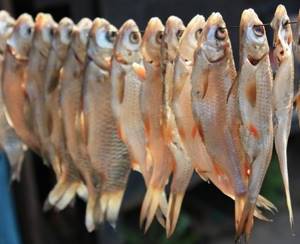
Preparing the fish
You can catch this fish in almost any body of water in Russia. It is best to dry roach in the spring, when the fish is most tasty, fatty and does not yet have the smell of mud. It is during this period that many individuals with eggs are caught.
If it is not possible to catch fish on your own, when purchasing, you need to pay attention to the appearance of the roaches. Fresh specimens have shiny scales without mucus and mud, transparent eyes, and red moist gills. High-quality roach smells like river water and freshness.
Before salting the roach, it is sorted by size. Small carcasses (up to 0.5 kg) are dried whole: unpeeled fish has a more pronounced taste. Larger specimens must be gutted so that they do not spoil during the cooking process. You can leave milt or caviar in the roach's abdomen.
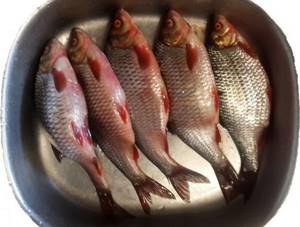
Prepared carcasses are washed in cold water and left without wiping to dry naturally.
Bridle (“wet”) method
Brine is the juice that comes out of fish when you cover it with salt and leave it in a tightly closed container. It is precisely such actions that are the essence of the described method. You should start by gutting and washing the fish. Then prepare a suitable vessel. This can be an enamel pan or even a bucket with a lid (if you plan to salt roach in large quantities). The carcasses should be placed there in even rows, leaving no gaps between the fish. Each row is filled with a large amount of coarse salt, and the next one is laid out on top. The topmost layer must be covered with salt so much that the fish are basically invisible.
Alternative: “dry” method of salting roach for drying
Dry salting is suitable for large specimens of roach, and for any other fish. This is the method that is recommended, for example, to those who want to learn how to pickle rudd with their own hands. In this case, you need to start, again, by gutting the fish, making a cut along the back. After that, the outside and inside of each carcass should be wiped with napkins or a paper towel. Instead of a pan, it is advisable to take a wooden box from which the secreted juice can flow out, so that the roach itself remains dry. This, in fact, is the essence of the described technique.
Rub each fish generously with salt on all sides and place in a box, adding a little more salt on top. Place in a cool but well-ventilated place, covered with transparent cling film. Salting will take 2-3 days, you can check its degree visually, you don’t even have to open the box. A transparent back with an amber tint is a sign that the process is over. After you have finished salting rudd or roach “dry”, you do not need to start drying or drying right away. First, rinse each of the carcasses very well under a strong stream of cold water. Then soak the fish in a basin for several hours. There the water should also be very cold, you can even add ice cubes. It is important that the liquid always remains clean. Therefore, it would not hurt to change the water 2-3 times during the specified time. When the fish begins to float to the surface, this will mean that it is already possible to begin further activities.
Distinctive features of the roach
One of its distinctive features is that the roach lives in large schools. In order to protect itself from enemies when predators approach, it adheres to large fish. Externally, it is a wide fish, the sides are flattened, the scales are large, the back is black, and the belly has a golden tint.
| Scientific classification | |
| Domain | Eukaryotes |
| Kingdom | Animals |
| Type | Chordata |
| Class | Ray-finned fish |
| Squad | Carp-like |
| Family | Carp |
| Genus | Roach |
| View | Vobla |
| International scientific name | Rutilus caspicus |
This fish is often confused with roach, a river fish. You can distinguish a roach from a roach by certain characteristics: the first is larger, its fins are gray with a black border, there are black spots above the pupil, the abdomen has a bluish-golden tint.

Roach, Taran and Siberian roach (click to enlarge the picture)
Many people argue about the difference between ram and roach and rudd and roach, and which fish tastes better. It turns out that ram, rudd and roach are related forms of roach. Roaches feed on plants; when there is a lack of food, the family begins migration in the hope of profit and moves from fresh water to sea water. Fish caught in the reservoirs of the Caspian Sea is called roach.
Roach differs from roach and roach in body shape: roach is more thick. The rudd is distinguished by its bright color, golden body, and red fins. “There is no friend for taste and color,” but only true gourmets and fish connoisseurs can distinguish each representative of the carp family by taste.
To learn more:
How to properly steam wheat for fishing
How to dry salted fish?
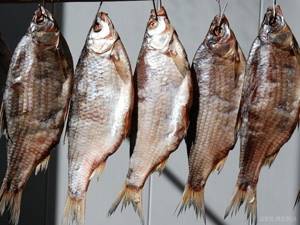
The best option is to organize the drying process in the fresh air, including a balcony. You need to stretch twines or clotheslines, on which the roach will be hung, and create a kind of awning over them from a mosquito net against insects. The latter can be replaced with regular gauze. It is also recommended to lightly moisten the roach carcasses with vinegar, then flies or any parasites will definitely not get to them. The drying process takes about a week. If you get a very large roach, you will have to wait 9-10 days.
If you don’t want to wait that long, you can dry it over the stove. It will only take a couple of days. But there are also disadvantages: you will have to leave a moderate fire constantly, since it will not be possible to quickly make a roach ram without maintaining a uniform temperature. Consequently, your utility bill will inevitably increase. In addition, in order to avoid accidents, someone will have to be on duty in the kitchen at all times. The fish can also absorb the odors of the gas and/or the food that you will be cooking during this time.
There are two ways to hang a roach on a rope: by the tail and by the eye. In the first case, the product will turn out less fatty. The drying process will occur evenly, due to which the fish can then be stored longer. But many note that the “ram”, which was hung by the eye by threading a piece of wire, a paper clip or a safety pin through it, is much more fragrant. The taste of such fish will also be more pronounced. But at the same time it will retain maximum fat. If the latter is not to your liking, then the option of hanging it by the tail will be more appropriate.
How to salt roach for wet drying
It is important that to salt roach you need to use coarse table salt, since it is the one that dissolves more slowly, absorbing almost all the moisture contained in the fish. To understand how to salt roach for drying, you need to learn the basics of salting any fish. To do this, you can use almost any deep container: an enamel bucket, a deep basin, a saucepan or a wooden barrel.
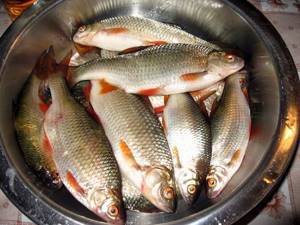
The bottom of the container must be covered with a generous layer of salt, and the fish itself must be laid in dense rows, carefully salting each of them. The last row must be salted so that the salt covers the entire fish.
To achieve an unusual and interesting taste, experts advise adding a little sugar.
After the roach has been carefully laid and salted, it must be covered with a flat lid and pressed down with a heavy weight to prevent the formation of gas bubbles and cavities in the roach, which contribute to the rotting of the fish. The brine that the fish releases after several hours is called brine, which is why the method itself received the name “brine.”
It is important that during salting, the fish is stored in a cold place, preferably in the refrigerator, since table salt penetrates into the fish itself slowly, and the cold helps prevent spoilage of the fish. Depending on the size of the roach, it must be salted for several days.
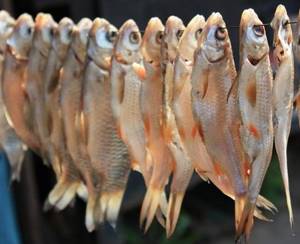
To check readiness, you need to take out one of the fish and try to bend it.
In prepared salted roach, the back becomes hard, the meat becomes dark gray, and the caviar becomes yellowish-red.
The finished salted fish must be removed from the container, rinsed thoroughly under cold running water, strung on twine, or bent paper clips threaded through the eye hole, then hung in a dry, ventilated room, covered with gauze so that insects do not land on the fish. It’s not difficult to guess how to dry roach correctly. It is worth noting that some fishermen advise leaving the fish not in the sun, but in a dry room with a draft, because that is when it will be juicy and meaty.
Useful properties of rudd
Composition and presence of nutrients
Rudd meat is lean, but it is quite rich in a variety of vitamins and minerals, as well as proteins. This inhabitant of rivers and lakes contains vitamin PP, which is indispensable for protein metabolism and is needed for the release of energy from carbohydrates and fats. It also has a good effect on the cardiovascular and nervous systems, maintains the normal condition of the skin and mucous membranes of the mouth and intestines, and under its influence the functioning of the stomach and pancreas is improved.
Of the minerals in rudd, the leading quantitative indicator is fluorine, which plays a major role in the prevention of caries and problems with tooth enamel, potassium, which regulates acid-base and water balance and ensures good physical activity and normal heart function, as well as phosphorus, which is necessary for metabolic processes. In addition, rudd meat contains chlorine, which is needed for digestion and helps cells and tissues get rid of toxins, and sodium, which is involved in the transport of amino acids. Fish contains magnesium, calcium, chromium, nickel, iron and molybdenum in smaller quantities.
Useful and healing properties
The benefits of rudd lie in the vitamins, minerals and acids it contains, and it is not very fatty. Fish contains easily digestible protein, which is important for the functioning of all internal organs.
Rudd helps to establish protein metabolism and provides the body with energy. Eating fish has a positive effect on the functioning of the nervous system, heart and blood vessels. It helps improve the appearance of the mucous membranes and skin. In addition, the functioning of the gastrointestinal tract returns to normal.
It is worth consuming rudd for bone health and preventing dental problems. Thanks to potassium, excess fluid is removed, blood pressure and acid-base balance are normalized. Also, thanks to rudd, you can improve the functioning of the digestive system and cleanse cells of toxins.
Dangerous properties of rudd
You should not use rudd only if you have an individual intolerance. But it is also very important to select, store and prepare fish correctly in order to protect yourself from parasites that may be contained in fish, as well as from food poisoning caused by stale or improperly prepared product.
Have you caught a rudd and don’t know what to cook with it? Try the delicious soup according to Serge Markovich's recipe.
Tatyana Eliseeva chief editor of the Food+ project
Ask a Question
Rating:
0
/10
Votes: 0
Material usefulness 0
Reliability of information 0
Article design 0
How to salt roach for dry drying
For large specimens of roach, the dry salting method is used. Each fish must be cut along the back, cleaned of the insides and wiped with a dry rag or paper towel. Rub the inside with salt and place the carcasses in rows in a wooden box, namely, belly-to-top.
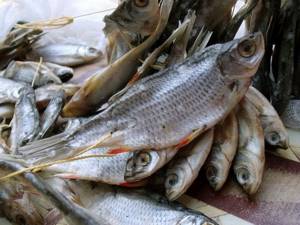
The scales of the fish also need to be sprinkled with salt, and the box itself should be left in a hole previously dug in a cool place and covered with cling film.
After the tips on how to properly salt roach are put into practice, the fish must be thoroughly washed under running cold water, however, it is best to soak it in clean, preferably ice water for several hours, while not forgetting to change the water, preferably 2-3 times. The fish is considered ready for drying when it begins to float in clean water, because it is then that the salting will be gentle, and the back will become amber-transparent, which is considered to be the “standard” for salting fish.
Almost every fisherman knows how to salt roach for drying, so if an experienced fisherman who knows a lot about salting fish advises you to add something of your own to the recipe, you should listen to his instructions.
More such recipes on our website:
- Homemade salted silver carp - proper salting of silver carp at home Salted fish is not only a tasty dish, but also a way to preserve the fish product in a suitable condition for consumption. Homemade salted silver carp is a simple dish.
How to salt bream when going fishing Every person who likes to fish has ever wondered how to salt bream for drying outdoors. To do this process in nature you need to be careful.
Salting bream for drying at home Well-organized salting of bream at home will not take much time and effort, and the result can be enjoyed by almost all lovers of beer and beer snacks.
Salting ram at home - how to salt ram correctly Everyone knows that salted fish lasts longer. Therefore, in order to stock up on ram for future use, you need to know how to properly salt ram.

